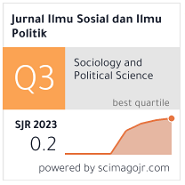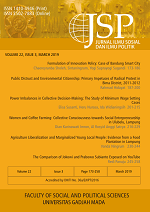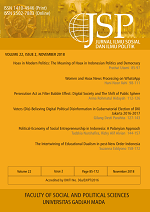The Dynamics of Power Relations and Injunctive Norms on Child Participation in Development Planning
Deden Ramadani(1), Johanna Debora Imelda(2*)
(1) Penabulu Research Institute, Indonesia
(2) Departement of Social Welfare, FISIP Universitas Indonesia, Indonesia
(*) Corresponding Author
Abstract
DKI Jakarta is one of the provinces with many young people. Around 2.9 million people, or 29 percent of the total population in DKI Jakarta province, are children. Unfortunately, the involvement of children in development planning in DKI Jakarta is still challenging. This research uses a qualitative approach with in-depth interviews and FGD techniques with children who are members of children's forums, child beneficiaries, children's forum facilitators, and government officials. This study examines children's participation in the development planning process in three areas in DKI Jakarta through Musyawarah Perencanaan Pembangunan/Musrenbang (Regional Development Planning Consultation Forum). Furthermore, this research is intended to reveal the obstacles found in involving children in development planning. The study results indicate a dynamic of power relations between children and adults, making children unable to voice their opinions for development. In addition, injunctive norms make children's participation feel artificial and procedural. A more inclusive model of children's participation in development is needed for children in order to accelerate the achievement of the SDGs in the province.
Keywords
Full Text:
PDFReferences
ASEAN Secretariat. (2019). Ending violence against children in ASEAN Member States: Midterm review of priority areas under the ASEAN Regional Plan of Action on the Elimination of Violence against Children 2016-2025. https:// www.unicef.org/ eap/sites/unicef.org.eap/files/2019-08/ ASEAN%20Mid%20Term%20Review%20RPA%20EVAC%202019.pdf
Bappenas. (2020). T ingkatkan Pemer ataan Pendidikan Berkualitas di Indonesia . https://www.bappenas.go.id/id/berita/ tingkatkan-pemerataan-pendidikan- berkualitas-di-indonesia-3Sabe
Barrett, M. D., & Buchanan-Barrow, E. (2005). Chil dren's Understandi ng o f S oc iety . Psychology Press.
Berkowitz, A. D. (2004). The Social Norms Approach: Theory, Research and Annoted Bibliography http://www.alanberkowitz. com/articles/social_norms.pdf
Cialdini, R. B. (2003). Crafting Normative Messages to Protect the Environment. Current Directions in Psychological Science, 12(4), 105-109. https://doi.org/10.1111/1467-8721.01242
Creswell, J. W. (1994). Research Design: Qualitative and Quantitative Approaches. SAGE Publications.
Cudjoe, E., Uggerhøj, L., & Abdullah, A. (2020). “We are consultants, not collaborators”: Young people’s experiences with child protection meetings in Ghana. Children and Youth Services Review, 109, 104748. https://www.sciencedirect.com/science/article/ abs/pii/S0190740919309879?via%3Dihub
Dillon, J., Greenop, D., & Hills, M. (2015). Participation in child protection: A small-scale qualitative study. Qualitative Social Work, 15(1), 70-85. https://doi.org/10.1177/1473325015578946
Hart, R. A. (1992). Children's Participation: From Tokenism to Citizenship. UNICEF.
Hulshof, H. (2019). Child participation in evaluating social protection projects: Do global development actors walk the talk? Progress in Development Studies, 19(1), 1-20. https:// doi.org/10.1177/1464993418805170
International Labour Organization. (1999). Worst Forms of Child Labour Convention, C182. https://www.refworld.org/ docid/3ddb6e0c4.html
Jamieson, S. B. W. S. L. (2017). Setting an ambitious agenda for children: The Sustainable Development Goals (South African Child Gauge 2017, Issue. http://www.ci.uct.ac.za/ sites/default/files/image_tool/images/367/Child_Gauge/South_African_Child_ Gauge_2017/Child_Gauge_2017-Setting_ an_ambitious_agenda_for_children%20-The_Sustainable_Development_Goals. pdf
Johnson, V. (2017). Moving beyond voice in children and young people’s participation. Action Research, 15(1), 104-124. https:// doi.org/10.1177/1476750317698025
Kang, L.-J., Hsieh, M.-C., Liao, H.-F., & Hwang, A.-W. (2017). Environmental Barriers to Participation of Preschool Children with and without Physical Disabilities. International Journal of Environmental Research and Public Health, 14(5), 518. https://www. mdpi.com/1660-4601/14/5/518
Kementerian Pemberdayaan Perempuan dan Perlindungan Anak RI. (2018a). Indeks Komposit Kesejahteraan Anak 2018. https:// kemenpppa.go.id/lib/uploads/list/3979c-buku-ikka-2018.pdf
Kementerian Pemberdayaan Perempuan dan Perlindungan Anak RI. (2018b). Survei Nasional Pengalaman Hidup Anak dan Remaja (SNPHAR) Tahun 2018. https:// www.kemenpppa.go.id/lib/uploads/ slider/49b98-infografis-snphar-2018.pdf
KPAI. (2020). Update Data Infografis KPAI – PER 31-08-2020. https://www.kpai. go.id/publikasi/infografis/update-data- infografis-kpai-per-31-08-2020
Maciver, D., Rutherford, M., Arakelyan, S., Kramer, J. M., Richmond, J., Todorova, L., Romero-Ayuso, D., Nakamura-Thomas, H., ten Velden, M., Finlayson, I., O’Hare, A., & Forsyth, K. (2019). Participation of children with disabilities in school: A realist systematic review of psychosocial and environmental factors. PLOS ONE, 14(1), e0210511. https:// doi.org/10.1371/journal.pone.0210511
Nah, K.-O., & Lee, S.-M. (2015). Actualizing children’s participation in the development of outdoor play areas at an early childhood institution. Action Research, 14(3), 335-351. https://doi.org/10.1177/1476750315621610
Nowak, H. I., Broberg, M., & Starke, M. (2018). Opportunity to participate in planning and evaluation of support for children with disabilities: Parents’ and professionals’ perspectives. Journal of Intellectual Dis abilities, 24(1), 5-20. https://d oi. org/10.1177/1744629518756227
Rizki, D. A., Sulastri, S., & Irfan, M. (2016). Pemenuhan Hak Partisipasi Anak melalui Forum Anak dalam Implementasi Kebijakan Kota Layak Anak di Kota Bandung: Studi Kasus Forum Komunikasi Anak Bandung. Prosiding Penelitian dan Pengabdian kepada Masyarakat, 3(3), 360.
Scott, J. C. (1976). The Moral Economy of the Peasant Rebellion and Subsistence in Southeast Asia. Yale University Press.
Setiyoningsih, D. A., & Yuliani, S. (2017). Partisipasi Forum Anak dalam Implementasi Kebijakan Kelurahan Layak Anak di Kota Surakarta:cStudi Tentang Partisipasi Forum Anak Jebres di Kelurahan Jebres. Jurnal Wacana Publik, 1(1), 46-55.
Smith, J. R., & Louis, W. R. (2008). Do as we say and as we do: The interplay of descriptive and injunctive group norms in the attitude– behaviour relationship. British Journal of Social Psychology, 47(4), 647-666. https://bpspsychub.onlinelibrary.wiley.com/ doi/10.1348/014466607X269748
Sudin Komunikasi, Informatika dan Statistik Kota Administrasi Jakarta Timur. (2019). Musrenbang Kecamatan Jatinegara Libatkan Forum Anak. https://timur.jakarta.go.id/ berita/4193/musrenbang-kecamatan- jatinegara-libatkan-forum-anak
Theobald, M., & Kultti, A. (2012). Investigating Child Participation in the Everyday Talk of a Teacher and Children in a Preparatory Year. Contemporary Issues in Early Childhood, 13(3), 210-225. https://doi.org/10.2304/ciec.2012.13.3.210
UN Comission on Human Rights. (1990). Convention on the Rights of the Child, Diakses https://www.refworld.org/ docid/3b00f03d30.html
UNICEF. (2019). SDG untuk Anak-Anak di Indonesia: Profil singkat provinsi DKI Jakarta. https://www.unicef.org/ind onesia/ sites/unicef.org.indonesia/files/2019-06/ Bahasa%20DKI%20Jakarta%20lowres2_0. pdf
van Bijleveld, G. G., de Vetten, M., & Dedding, C. W. M. (2020). Co-creating participation tools with children within child protection services: What lessons we can learn from the children. Action Research, 1476750319899715. https://doi.org/10.1177/1476750319899715
Article Metrics
Refbacks
- There are currently no refbacks.
Copyright (c) 2023 Jurnal Ilmu Sosial dan Ilmu Politik

This work is licensed under a Creative Commons Attribution-NonCommercial-NoDerivatives 4.0 International License.






















